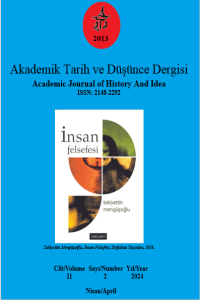Şəhabəddin Söhrəvərdinin“Fi Həqiqətül-Eşq Ya Munisul-Uşşaq” Əsərinin Tərcüməsi və Şərhi
Öz
“Munisul-uşşaq” Söhrəvərdinin farsdilli risalələri arasında öz məzmun gözəlliyi ilə fərqlənir. Bu əsər sufi əsəri olsa da, məzmunu bütünlüklə “Yusif və Züleyxa” dastanınından götürülmüşdür. Söhrəvərdiyə qədər və ondan sonra “Yusif və Züleyxa” mövzusunda yazılan heç bir əsərin süjeti bu qədər dolğun və maraqlı qurulmamışdır. Əsəri maraqlı edən cəhət hüsn, eşq, hüznün obrazları üçün Yusif, Züleyxa və Yaqub surətlərindən istifadə olunmasıdır. Belə bir metoddan istifadə olunması farsdilli sufi ədəbiyyatın birinci, bəlkə də sonuncudur. Əsərin adından da göründüyü kimi burada eşq dastanından bəhs olunur. Amma məqsəd təkcə eşqin bəyanı yox, həm də ağıl və mərifətin bəyanıdır. Bu əsərin dili o qədər rəvan və cəlbedicidir ki, oxuduqca ondan ayrılmaq olmur. Əsərdə Quran ayələri, fars və ərəb dilində kiçikhəcmli şeirlər, iki Quran qissəsi vardır.
Anahtar Kelimeler
Kaynakça
- Jafar, S. S. (1375). Sharh-e resayel-e farsi-ye Sohreverdi. Howzhe-ye honari
- Qurani-Kərim, (1991). (Tərc. Z.Bünyadov və V. Məmmədəliyev). Bakı.
- Sohreverdi, S. (1377). Qessaha-ye Sheykh Ishraq. Nashr-e markaz.
A Translation and Interpretation of Shihab Al-Din Suhrawardi’s “Fi Haqiqat Al-‘Ishq / Munis Al-‘Ushshaq” Work
Öz
Munis al-Ushshaq is distinguished among Suhrawardi’s Persian tractates with its elegance of content. Despite beign a Sufi work, its content was takes as a whole from the “Yusuf and Zulaikha” work. The plot of no work written on the topic of Yusuf and Zulaikha before and after Suhrawardi could become so perfect and interesting. Elements making the work so interesting were the usage of the characters of Yusuf, Zulaikha and Ya’qub for features as elegance, love and lament. It was the first and also probably the last time such a method used in Persian Sufi literature. As seen from its name, the work presents a story of love, where, at the same time, declamation of love is made together with the declamation of wisdom and the gnostic knowledge. The language of the work is so fluent and attractive that urges the reader to continue reading. It contains verses from the Quran, small-size poems in Arabic and Persian and two stories from the Quran.
Anahtar Kelimeler
Kaynakça
- Jafar, S. S. (1375). Sharh-e resayel-e farsi-ye Sohreverdi. Howzhe-ye honari
- Qurani-Kərim, (1991). (Tərc. Z.Bünyadov və V. Məmmədəliyev). Bakı.
- Sohreverdi, S. (1377). Qessaha-ye Sheykh Ishraq. Nashr-e markaz.
Ayrıntılar
| Birincil Dil | Türkçe |
|---|---|
| Konular | Türk Halkları ve Toplulukları |
| Bölüm | Makaleler |
| Yazarlar | |
| Erken Görünüm Tarihi | 5 Mayıs 2024 |
| Yayımlanma Tarihi | 7 Haziran 2024 |
| Gönderilme Tarihi | 16 Şubat 2024 |
| Kabul Tarihi | 15 Nisan 2024 |
| Yayımlandığı Sayı | Yıl 2024 Cilt: 11 Sayı: 2 |

